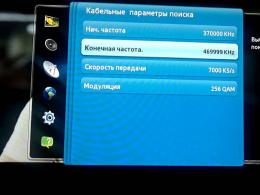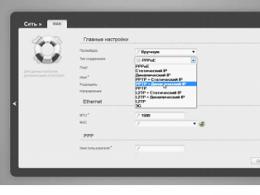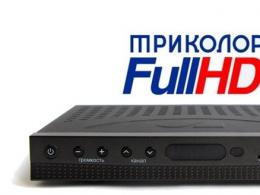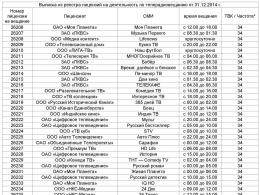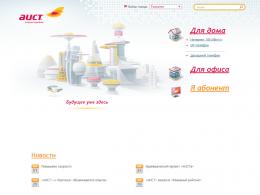K module for digital television. CAM modules for T2 and beyond
The development and widespread use of digital television required technical solutions from manufacturers of television receivers that allow them to receive television programs broadcast both directly from satellites and cable or satellite TV providers. Many well-known companies coped with this problem quite easily by equipping television panels with built-in digital receivers (tuners). And the issue of additional viewing of paid video content from different providers was resolved using a special module for the TV. About the types and capabilities of this equipment, as well as the rules for its installation - in the material below.
What is a CAM module
As of the end of 2018, almost all modern TVs (LG, Samsung, etc.) allow you to receive digital television programs, for which you just need to connect a cable coming from a satellite dish (dish) to the appropriate input. However, in this case it is possible watch digital channels only unscrambled- after all, tuners built into TVs do not have the keys necessary for paid video content. Also, television receiver manufacturers, as a rule, do not provide for the possibility of flashing built-in receivers and / or entering keys using a smart card, which excludes the possibility of watching pay TV channels coming from satellite and cable TV providers.
In order for TV owners to be able to view paid content, TV receivers manufacturers provide the ability to connect an external CAM module, with which you can decode the received TV signal and tune channels. In the general case, a CAM module for a TV (Conditional Access Module) is a small computer designed to decode a digital video signal and then match it with the model of the TV receiver on which the owner installed it.
Principle of operation
This device only works with special smart card, which is purchased from the provider and installed in the CAM module. And the module directly connects to the TV through the Common Interface slot (CI-slot) or connects to it using a special CI adapter (5V only), which is usually included in the delivery set of the TV receiver.

Important! After the CAM-module with the inserted smart card is installed and connected to the TV receiver, the subscriber is identified, and the program will start reading the video signal decryption keys and decoding them into a format acceptable for the TV.
Only in this way the user gets the opportunity to receive digital television, both free and commercial channels.
Advantages
According to the reviews of the owners of modern TVs with built-in receivers (Sony Bravia, etc.), CAM modules have a number of advantages, including:
- reception of coded TV channels;
- the ability to do without the purchase of an expensive external receiver;
- ease of installation of the CAM-module and automatic tuning of the TV receiver;
- control the module using the TV remote control.
Types of CAM modules
According to technical features and functionality, there are several types of CAM modules.

Installing the CAM module in the TV
Depending on the model of the television receiver, there may be two options for installing the CAM module:
- via CI slot.
- using a special CI adapter.

Attention! Before you buy a CAM module, you should make sure that your TV panel can receive unencrypted (free) digital channels. If such a translation is not provided, then the installation of the CAM module seems useless.
Algorithm
The installation sequence of the CAM module is the same in all cases and boils down to:
- disconnecting the TV receiver from the power supply network;
- installing a smart card into the module in such a way that the contact pads of the CHIP are facing the side where the colored label is pasted (in this case, the smart card must be inserted all the way);
- connecting the CAM module to a television receiver in accordance with its instruction manual;
- turn on the TV and check the reception of scrambled channels.


Precautionary measures
To ensure the safety and performance of the CAM module, you must adhere to some recommendations. Thus, rough mechanical impacts should be avoided, as a result of which damage to the body of the device and the components inside it is possible. And the installation and connection of the modules must be carried out in strict accordance with the instructions attached to the television receiver. In addition, you should:
- do not overheat the module;
- do not bend the smart card and do not store it near sources of strong electromagnetic radiation;
- do not remove the smart card from the module without special need;
- do not remove the CAM module from the TV receiver unless absolutely necessary.
ISP protection and the possibility of hacking
Due to the fact that there is quite tough competition among providers offering paid television content, they are forced to somehow label their products. They do this in a variety of ways. signal encoding, which allows you to provide your client with the opportunity to receive the content ordered and paid for by him.
However, the main coding formats have long been known and standardized, thanks to which users deprived of decency can easily crack access codes to broadcast TV channels. To protect against hacking, providers are forced to constantly change code combinations, which naturally complicates hacking. Satellite codes are also changed, which are then transferred to service providers for flashing client smart cards.

Providers most often use the encryption technique, which is based on key redundancy algorithm. It consists in the following - a package of television programs is formed from the corresponding lists of codes. In addition, each channel receives a unique combination, which includes the provider's key and a set of user codes that have paid for the service. Based on this cipher, consisting of a specific digital set, the client is able to accept the software package ordered by him.
However, after a certain period of time, the provider changes his code, and then the whole set of client keys should stop working. By changing the combination, the service provider assigns a new key to smart cards only to those customers who have paid for the commercial channel package on time. For other users, reception of programs is terminated.
Interesting! At present, the BetaCrypt 2 code system, which uses a complicated method of searching and assigning keys, has become widespread. For the previously used Conax and BetaCrypt coding systems, the algorithm for creating digital combinations is completely deciphered.
So, thanks to the CAM-module for television receivers, many paid TV channels from various providers become available to users. As you can see, the installation of such equipment is not particularly difficult, but for its long and successful operation during operation, precautions should be taken.
Best TVs of 2019
TV LG 43UK6200 on Yandex Market
TV Sony KD-55XF9005 on Yandex Market
TV LG 49UK6200 on Yandex Market
TV Sony KD-65XF9005 on Yandex Market
LG OLED55C8 TV on Yandex Market
To use the cam module, you need:
- connection to a digital television network
- TV presence:
- built-in digital tuner that receives a signal in DVB-C format;
— built-in MPEG-2/MPEG-4 decoder;
- CI (Common Interface) slot for installing a CAM module.
As a rule, all TVs older than 2013 allow you to install a cam module (for Samsung TVs - starting from 2009, Philips - from 2011). Setting up the cam module to receive a signal from any digital television operator is identical, since you are not setting up the cam module, but the TV itself. Below are the cam-module settings for the main brands of TVs.
Installing the CAM module
- Disconnect the TV from the power supply.
- Carefully insert the CAM module without the access card. Make sure the module is fully seated in the slot.
- Insert the access card into the CAM module with the TV logo. The side of the card with the chip must face the CAM module. The edges of a properly installed access card must not extend beyond the CAM module. For MTS television, the card must be activated.
- Plug in your TV.
After switching on, information about the presence of the CAM module will appear on the TV screen.
Setting up the CAM module
- Setting up a cam module on a SAMSUNG TV
Enter the menu (green button) - "Channel" (pictogram "Satellite dish") - "Auto tuning" - signal source - "Cable" - "Digital" - "Start" - Setting up a cam module on a PHILIPS TV
On the back of the TV, you need to find a sticker where, for each tuner (DVB-T and DVB-C), there is a list of countries in which, according to Philips, digital TV is available (at the time the TV was released). If Russia is not there, then it will be necessary to put another one.
House Icon - Configuration - Setup - Reinstall Channels - Country Labeled on Rear Panel - Digital Mode - Cable - Automatic - Start
2011 Philips TV models:
"House" - "Installation" - "Search for channels" - "Reinstall channels" - "country indicated on the sticker on the rear panel" (usually France, Finland or Germany) - digital mode "Cable (DVB-C)" - in the line "Network frequency" we drive in the frequency - in the line "Transfer rate" we drive in the speed - select the line "Scanning frequencies". - Setting up the cam-module on a SHARP TV
If the “DTV MENU” item is not on your TV, then you need to select another country - France, Switzerland, Sweden or Finland.
Button - "DTV" - "DTV MENU" - "Installation" - "Auto installation" - "OK" - Setting up a cam module on a SONY TV
Not all SONY TVs are equipped with a digital TV (DVB-C) tuner, so first check if your TV can receive a signal: models with a DVB-C tuner are marked KDL-**EX*** or KDL-**NX** *. For models KLV-**BX*** etc. no DVB tuners.
Button "MENU" (or "HOME") on the remote control (green) - "Settings" - "Digital configuration" - "Auto search for digital stations" - connection type "cable" - type of scanning "full scan" or "manual" - enter the frequency - Access code "Auto" - enter the symbol rate - "start" - wait for the channel search to finish. - Setting up a cam module on a Panasonic TV
"Menu" - "Settings" - "Menu analog. settings" - "Add TV signal" - a tick on the line "DVB-C" - "Start auto tuning"
After the channel search is completed in the main menu in the "Settings" item, the line "DVB-C Tuning Menu" will appear, where you can correct the setting in manual mode (set the frequency and speed). If your TV asks for a search step, enter 8MHz. - Setting up a cam module on a Toshiba TV
Language "Russian" - DTV tab manual tuning - OK - enter the frequency, modulation, symbol rate - OK - the search for channels will start - Setting up a cam module on an LG TV
"Menu" (Menu) - "Options" - the country Finland or Germany - the menu "Settings" - "Auto search" - the method of connecting to the TV "Cable" - "Settings": search type is fast, Frequency (kHz), Speed. Characters, Modulation, Network ID: auto - save all settings.
Be sure to turn off "Automatic Channel Update", otherwise the TV will periodically reset the channel list you have configured.
Where to buy MTS cam-module? Who can answer my questions?
You can fill out an application on this site: just click on the red "Connect" button at the top. The manager will call you back, answer all questions, arrange the delivery of equipment or tell you where you can come for a purchase.
What is better to choose - a cam-module or a TV set-top box?
If your TV supports the installation of the module, then select it. This compact device is installed inside the TV and saves space. The quality of the image and the set of channels they do not differ.
Is it possible to buy the MTS module separately, without an antenna?
Oh sure. Such a set costs 3400 rubles.
Does the CAM module allow you to watch free channels from the same satellite?
We would put it differently. The module does not participate in this process. If your TV has DVB-S2 support, it will find open (unencrypted) channels on the ABS-2A satellite and you can watch them.
Is it true that you need a module to watch UltraHD (4K) channels?
Yes it's true.
If the TV does not support the HEVC codec, but has DVB-S2 and CI + options, can a cam module be installed in it?
Yes, you can, and everything will work. But those channels that are encoded using HEVC will not be shown.
I have a cam module for MTS cable TV, can I use it for satellite?
This will not work, the devices are not interchangeable, as they differ in the software installed on them.
Do I need to buy and install an antenna for the module itself?
Yes, of course, you always need an antenna to watch satellite TV.
What is the difference between cam module version 1.3 and 1.1?
Compared to 1.1 CI+, 1.3 added:
various enhancements of Content Control mechanism
coordination of parental control PIN code handling between CAM and its host – synchronization of parental control settings between the module and the device in which it is installed (TV or set-top box)
better IP communication support (increased data throughput)
VOD support - added support for video on demand service
a new Operator Profile resource allowing CAM to adapt non-standard broadcast-specific service information to standard DVB format understandable by Host. – added settings that allow you to adapt the broadcast to the parameters of the received device
Conditional access module Tricolor CI+ Ultra HD (Center) is a compact device designed for broadcasting satellite channels without the use of wires. The smart card is installed in a special slot on the TV, after which the setting is carried out automatically. The model supports more than 200 channels with Ultra HD resolution and allows you to listen to up to 30 radio stations. Switching programs is carried out using a conventional remote control. The Russified menu makes it easy to find the necessary content. The module supports DVB-S and DVB-S2 broadcasting standards. The model provides access to the Tricolor package for a period of one month; a satellite dish is required for viewing.
CI+ conditional access module for receiving "Tricolor TV" with Ultra HD support (project "Tricolor TV. Center")
1.Description
CI + module is a compact equipment that, if there is a CI slot on the TV with support for the CI + standard and the ability to receive satellite television, will allow you to view Tricolor TV channels. CI + module is inserted into the TV, which will save you from unnecessary wires.
The TV remote control is used to change channels.
Together with the CI + module, you must purchase and connect a satellite dish, if it is not already installed.
2.Subscriptions included
The kit already includes access to the One Ultra HD channel package for 1 month, which provides viewing of more than 200 TV channels, including high definition (Full HD) and ultra high definition (Ultra HD), and listening to more than 30 radio stations.
3.Connection and setup
Before purchasing and connecting equipment, read the instructions. Make sure your TV supports the DVB-S2 satellite broadcast standard 3 and is equipped with a CI+ v 1.3 or later 4 slot. To view Ultra HD channels, you need a TV that supports Ultra HD format and HEVC 5 image encoding version 5.0 or later. Install and configure the satellite dish, place the smart card into the module slot and insert the module into the dedicated CI+ slot on the TV. Connect the LNB IN output of the TV to the satellite converter with a coaxial cable and select the appropriate signal source from the TV menu.
Contents of delivery
______________________
1 Full HD - resolution 1920×1080 pixels. Used in high-definition television (HDTV) broadcasts.
2 Ultra HD - resolution 3840×2160 pixels. Ultra high definition television, 4K resolution (Ultra High Definition Television, UHDTV).
3 DVB-S2 is a broadcasting standard for satellite, digital television, including ultra-high definition resolution.
4 CI + slot in the TV set, which allows you to view encrypted channels using CAM-modules and decoding cards.
5 HEVC - H.265 video coding standard (High Efficiency Video Coding).


